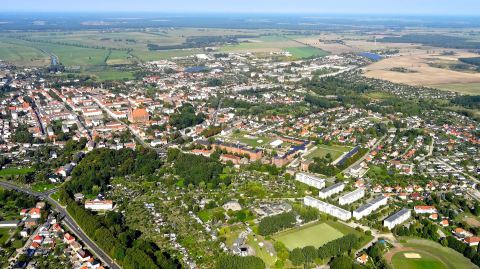Location - Pasewalk / Germany
Pasewalk is located in northeastern Germany in the federal state of Mecklenburg - Western Pommerania. Here, in the midst of green fields, halfway between Berlin and Usedom and in the immediate vicinity of Stettin, lies the city of Pasewlak with its own airfield.
The 750-year-old city on the river Uecker features historic buildings and monuments which are worthwile exploring. Significant parts of the once 2,488 m long and 8 m high original city wall with its gates, towers and guard houses still exist. For example the "Powder Tower" and the "Kiek in de Mark" (look-out), Pasewalk's city symbol. Since 1996, the "Prenzlau Gate" houses the municipal museum and the artist Paul Holz Memorial. On 180 m² of exhibition area, both in the gate itself and the neighbouring building, the visitor experiences fascinating and important exhibits of the city and the region's history.
The second floor of the gate is dedicated to the 270-year-old garrison town's history rich in tradition. On the basis of militaria, such as weapons and tunics, as well as 14 richly illustrated boards, the historical development starting from the deployment of the Prussian Dragoon Regiment in the city in 1721 up to the withdrawal of the last units of the Federal Armed Forces in 1992 is displayed. Furthermore the Pasewalk municipal museum features the largest public collection on display of the Pomeranian pen drawing artist Paul Holz (1883-1938). On the third floor of the Prenzlau Gate Tower there is the Paul Holz gallery, offering great views over the city and the countryside. 24 pen drawings from this north German artist can be admired here in varying cycles.
There are three historic churches in Pasewalk. The oldest one, dating back to the 13th Century, is the Nikolai Church. St. Mary's Church, one of the most beautiful hall churches in northern Germany was started in the 14th Century. On 3rd and 4th December 1984, the fieldstone basement of the tower yielded and the northwestern corner collapsed, resulting in a huge hole gaping from the ground floor up to the octagon. With the blasting of the tower on 8th December 1984, the wall of the nave collapsed, taking the Kaltschmidt-organ from 1853 with it. From 1987 to 1994 the tower and the first bay of the nave were rebuilt. The latest church is the catholic St. Otto Church, named after the Pomeranian missionary Otto of Bamberg, which celebrated its 100th anniversary recently.
However, Pasewalk does not only live in and through its history. Today, the city presents itself as a small, modern town with 11,000 inhabitants. The economic growth of the city is a top priority. There is a wealth of skilled workers in a number of key sectors, which benefits from Pasewalk's vicinity to Neubrandenburg and its University with approximately 2,100 students and ca. 330 graduates each year plus 25,000 graduates from Stettin Universities (Poland). There is a functioning infrastructure of governmental agencies, universities / colleges and companies.




